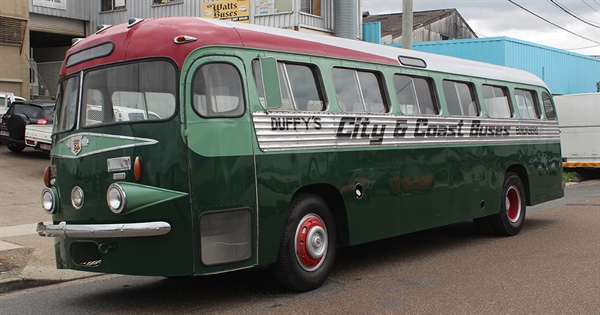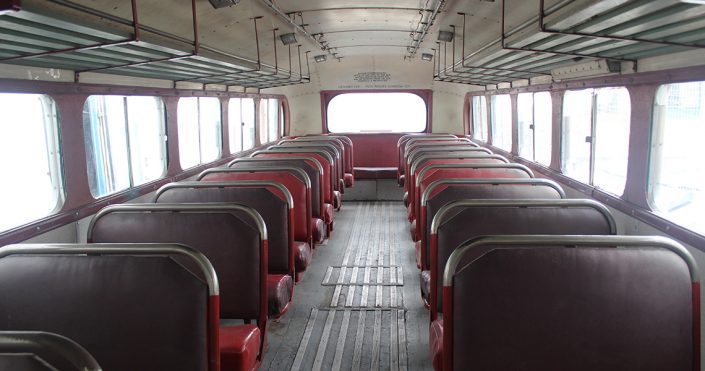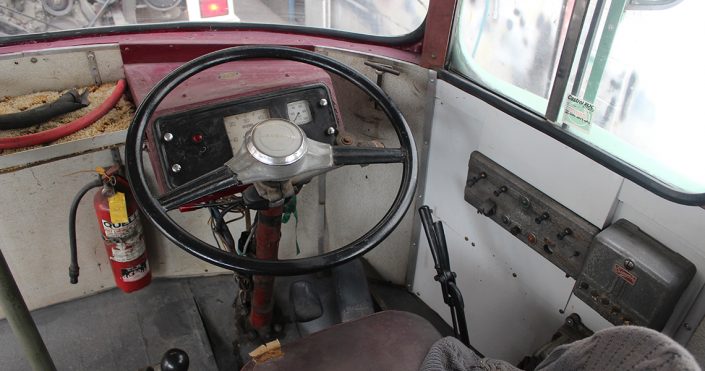1957 TIGER CUB BUS
Owner: BARRIE WATT Published: November 2014
Barrie Watt has been in the coach building business his entire working life.
His family goes way back in the business – back to before the formation of the MTAQ, when the Association was known as the Garage and Service Station Proprietors Association (GASSA). In fact, the family business, Watt Bros., has been in the coach building trade since 1920 and was even represented at the very first meeting of GASSA, on September 30, 1929.
So it’s not, perhaps, a surprise that Barrie has an interest in classic buses and coaches and now owns several, including this one – a 1957 British Leyland Royal Tiger Cub.
That name only really refers to what’s underneath the bus body – the chassis, the engine, the mechanical parts – for the buses and coaches of the period were a blend of the engineering skill of the manufacturer and the creativity of the coach builder.
A bare chassis would be delivered by the manufacturer and it was local coach builders, working from their own designs, who would create the coach bodies. This combination of talents resulted in some truly wonderful vehicles.
For Barrie, there is a special connection with this particular bus – and with all the classics in his collection. For all of them were designed and built by his family’s company.
“This bus was built for Duffy’s City Buses in Bundaberg,” he says. “Bus builders had their own designs and Watt Bros. would ask the client what shape they’d like and then build it. When this bus was built, it was the predominant shape of the day.”
In truth, it wasn’t just the body, the shell, that the company built. Back then, Watt Bros. built everything.
“They used to do the whole lot,” says Barrie. “The panels were rolled in a machine and welded together. The windows, the seats, the bumper bars – pretty much everything was made here.”
Barrie’s connection to the Royal Tiger Cub actually goes even deeper than the involvement of the family company. Back in 1957, he actually had a hand in building it.
“I worked on this bus. I painted it!” he says. “I can’t remember exactly what else I might have done to it back then – I might have put the seats in, and the windows too.
I served my time as a coach and motor painter but when you worked for Watt Bros. you had to do everything. You’d paint a bus, put panels on, put the floors in, put the seats in, put the lino and rubber in – you had to be versatile.”
At the time, the young Barrie probably didn’t think the Cub, after a lifetime of service on the roads and highways around Bundaberg, would find its way back home to Brisbane, but Watt Bros.’ involvement with the owners, working on and repairing their bus fleet, meant they never lost track of it.
“Duffys ran it for thirty years and I bought it back from them,” says Barrie. “I was doing the repairs on their other buses, repainting and so on, and they said they had to get rid of it at the end of the year and I bought it.”
So, in 1987, the Cub found its way back into the hands of the company, and the man, that had built it.
But nostalgia was not the motivation for Barrie buying the Cub. There was a sound, and rather unusual, business case for the purchase.
“I used to do a lot of work for Movie World at the time,” he says. “The studios had opened up on the Coast and they used to hire buses from me for the films being made. That’s the main reason I bought it – when they were making 50’s or 60’s era films, they needed vehicles from that era.
“This one was used in a few things. There was a film called The Flood, another called Fields of Fire, and it also featured in the Kylie Minogue movie The Delinquents.”
And it’s the movie connection that explains why the Cub was finally restored only a couple of years ago.
“The condition wasn’t too bad when I bought it,” says Barrie. “I didn’t do anything with it for a while because, in a slightly dilapidated state, they fitted into the films better.
If you had a restored bus, people watching the movie would know that it was a ‘fake’.”
And so restoring the Cub only began in earnest when the film work began to slow down.
“That was about five years ago,” says Barrie. “We put it into the workshop here and worked on it in between jobs.
“We finally got it finished a couple of years ago,” he adds. “We had to replace some of the wood framework, and some of the panels on the outside were a bit rusty and, of course we had to give it a complete repaint back to the original colours too.”
“I painted it when it was new and now I’ve done it all over again!”














